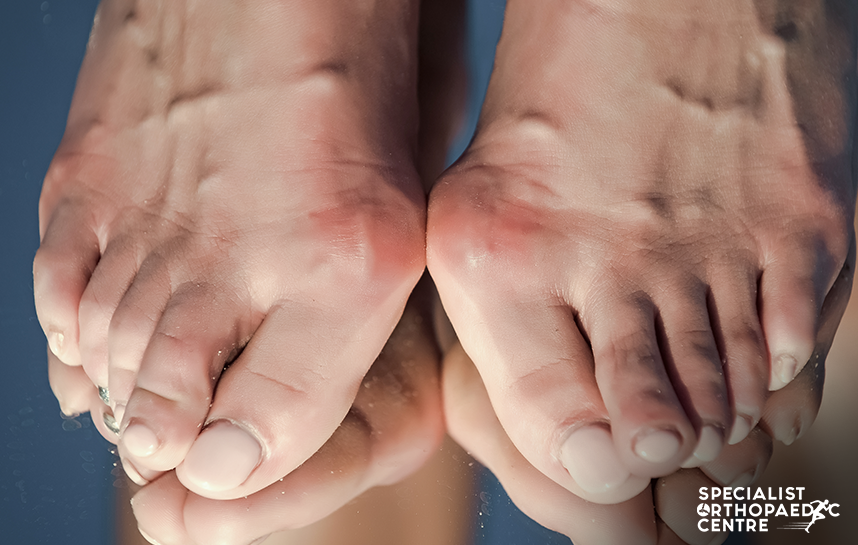Noticed a tiny protruding bump that has formed on the joint at the base of your big toe? You are most likely suffering from bunion, a condition in which bones in the front part of your foot move out of place, resulting in a bump. You may also notice that the skin over the bunion appears red and sore.
While the condition sounds serious, a bunion oftentimes does not require invasive medical treatment unless you are experiencing persistent pain, decreased movement of your big toe, or simply want to resolve it for cosmetic reasons.
Despite bunions being fairly common and not always a cause for concern, there are still many myths surrounding the condition. Hence, we will be debunking them in this article to help you gain a deeper understanding – read on to find out more.
1. Wearing high heels causes bunions
It is inaccurate to attribute high heels as the cause of bunions because not everyone who wears high heels end up developing the condition. However, prolonged wearing of high heels can force the weight of your body onto the ball of your feet. This increased pressure plus unnatural positioning of your toes may make your feet more susceptible and encourage the forming of bunions. Frequent wearing of high-heeled shoes may also exacerbate any underlying structural problems such as foot deformity and arthritis, making bunions develop quicker and progress faster. Persistent flexed position of the ankle also causes the big toe and the little toes to curl up and deviate, hastening the formation of a bunion deformity over the big toe.
2. Bunions are a hereditary condition
Bunions form due to a combination of internal and external factors that cause instability and a bony protrusion at the joint of the base of your big toe. Hence, you may have inherited your parents’ feet with a shape and structure that are more prone to bunions forming, rather than inherited their bunions. Luckily, there are ways such as wearing comfortable shoes and doing exercises to strengthen your feet that can help to delay or prevent the bump from forming. A simple example will be familial flatfeet, where the mom, child or the aunt may have flexible flatfeet contributing to looser ankle or foot ligaments. This group of family members may be more prone to developing bunions.

3. All bunions are painful
Contrary to popular belief, not all bunions cause pain and you may not even notice you have one until you examine your foot closely. Nevertheless, wearing tight and narrow shoes can cause some bunions to worsen and eventually become painful. If the long-standing bunion becomes symptomatic with pain, it is important to take note of the following – there could be bursal inflammation, erosion of the cartilage or a painful callosity at the bone protuberance. If pain persists and discomfort becomes unbearable, it is advisable to see an orthopaedic surgeon in Singapore as soon as possible for a diagnosis and the appropriate treatment.
4. Bunion surgery is painful
If you do decide to visit an orthopaedic surgeon for medical attention, there is the possibility of having to undergo bunion surgery. This surgical procedure involves correcting the deformity to relieve pain and realigning the shape of the foot.
Modern surgical techniques and anaesthesia have allowed patients with bunion surgery to walk immediately post-surgery and go home the same day post procedure. Corrective bunion surgery may be worth your time and recovery period if it allows you to wear normal shoes and perform your daily activities or sports without pain, and especially with the recently available effective minimally invasive bunion surgery techniques.
5. Bunions will come back after surgery
As much as we hope that bunions are kept at bay forever after surgery, there is a very small possibility for them to recur. Hence, the right surgical technique is needed to address various bunion deformities to lower the chances of recurrence. The probability of lifetime recurrence is slightly higher in a younger patient given that they take millions steps more in their lifetime compared to an older patient. However, recurrence depends very much on the severity of deformity, age of the patient and the technique of correction.
You will most probably be asked to wear more accommodating footwear following bunion surgery so that your feet heal and adjust to the new shape. During this time, your orthopaedic surgeon will advise and guide you to prevent a recurrence from happening.
Find out more about bunions at Specialist Orthopaedic Centre

If your bunions are causing you pain and affecting your quality of life, do not hesitate to visit Specialist Orthopaedic Centre for diagnosis and treatment.
Dr Kannan Kaliyaperumal is an experienced foot and ankle specialist surgeon who is well-trained in minimally invasive bunion surgery, employing the latest techniques in treatment and will be able to provide you with personalised advice depending on your condition.


